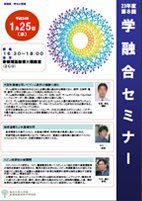AY2011 8th Gakuyugo Seminar
- Date&Time:
- Jan 25, 2012 16:30 - 18:00
- Venue:
- Large Lecture Room (2C0), New Frontier Science Bldg.

The challenge of deciphering genome sequences using large computers
Lecturer Masahiro Kasahara
The genome sequence is the most basic information necessary to form living organisms, and is routinely used in the fields of medicine, biology, agriculture, pharmacy, and engineering. DNA sequencers are used to decipher the genome sequence, but the length of the sequence that a DNA sequencer can read at one time is much shorter than the size of the genome. Therefore, in order to decipher the entire genome sequence, it is necessary to randomly sample a large number of fragmented sequences from the genome, read the sequences, and fit the data together like a puzzle. This calculation is called genome assembly. The output of DNA sequencers has been increasing by several orders of magnitude due to recent technological improvements, and we will introduce how large computers are being used and devised to cope with this increase in data volume.

Global Warming and Ice and Sea Utilizing
Professor Hajime Yamaguchi
As global warming progresses, plans for the development and utilization of ice areas are advancing at a rapid pace. In this paper, we will examine the technical aspects of sustainable use of the ice area and the best mix of mitigation and adaptation measures to global warming.

New Developments in Spin Current Research
Professor Yoshichika Otani
Spintronics research has entered a new phase from the conventional type, in which spin polarization currents are used to control physical properties such as spin torque magnetization reversal and precession, to a new generation type, in which pure spin currents, which are the flow of spin angular momentum without charge flow, are used to create novel physical properties in a variety of materials from metals to insulators. In this talk, we will discuss the basic spin current physics related to the generation, manipulation, and detection of pure spin currents using magnetic/non-magnetic hybrid nanostructures called in-plane spin valves, followed by an overview of spin current research, which is currently the subject of fierce research competition worldwide.
*The contents of this page were developed based on a machine translation.

